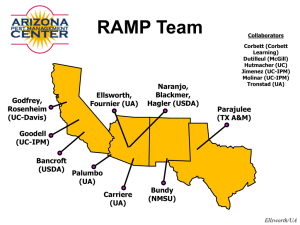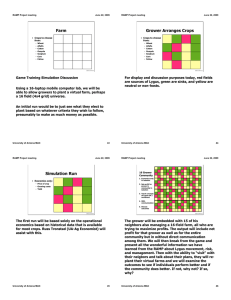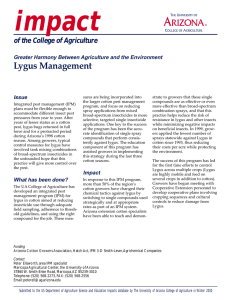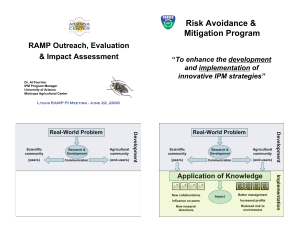Lygus IPM When is ‘Done is done?’ Making late season insect control decisions
advertisement
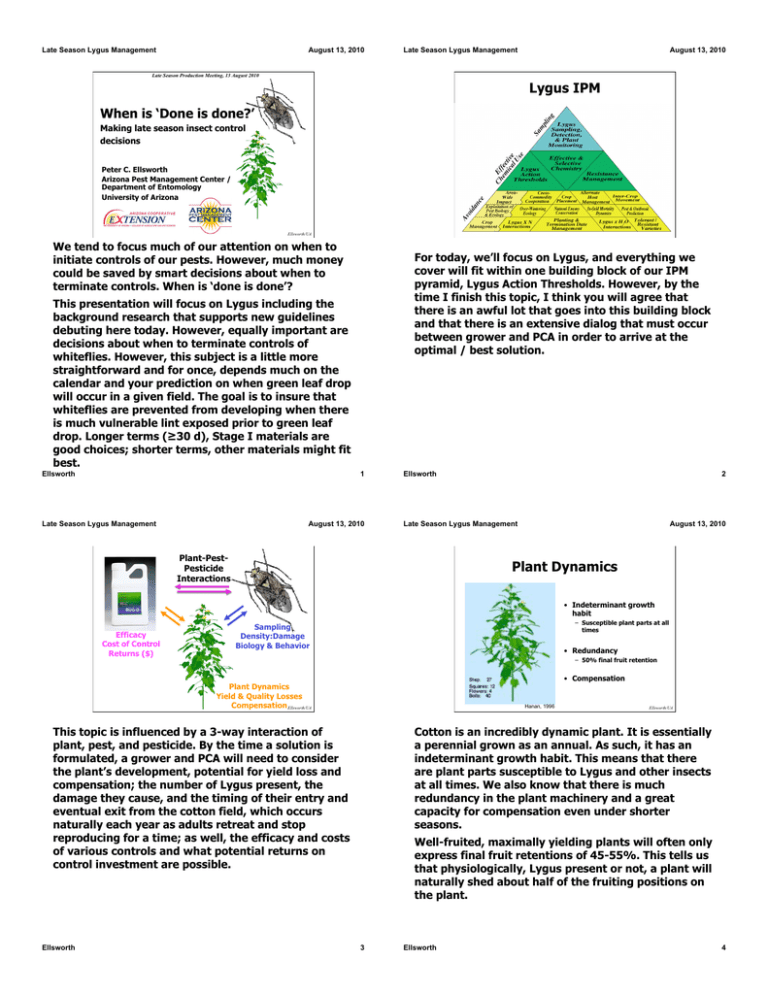
Late Season Lygus Management August 13, 2010 Late Season Lygus Management August 13, 2010 Late Season Production Meeting, 13 August 2010 Lygus IPM When is ‘Done is done?’ Making late season insect control decisions Peter C. Ellsworth Arizona Pest Management Center / Department of Entomology University of Arizona Ellsworth/UA Ellsworth/UA We tend to focus much of our attention on when to initiate controls of our pests. However, much money could be saved by smart decisions about when to terminate controls. When is ‘done is done’? For today, we’ll focus on Lygus, and everything we cover will fit within one building block of our IPM pyramid, Lygus Action Thresholds. However, by the time I finish this topic, I think you will agree that there is an awful lot that goes into this building block and that there is an extensive dialog that must occur between grower and PCA in order to arrive at the optimal / best solution. This presentation will focus on Lygus including the background research that supports new guidelines debuting here today. However, equally important are decisions about when to terminate controls of whiteflies. However, this subject is a little more straightforward and for once, depends much on the calendar and your prediction on when green leaf drop will occur in a given field. The goal is to insure that whiteflies are prevented from developing when there is much vulnerable lint exposed prior to green leaf drop. Longer terms (!30 d), Stage I materials are good choices; shorter terms, other materials might fit best. Ellsworth 1 Late Season Lygus Management August 13, 2010 Ellsworth 2 Late Season Lygus Management Plant-PestPesticide Interactions August 13, 2010 Plant Dynamics • Indeterminant growth habit Efficacy Cost of Control Returns ($) – Susceptible plant parts at all times Sampling Density:Damage Biology & Behavior • Redundancy – 50% final fruit retention • Compensation Plant Dynamics Yield & Quality Losses Compensation Ellsworth/UA Hanan, 1996 This topic is influenced by a 3-way interaction of plant, pest, and pesticide. By the time a solution is formulated, a grower and PCA will need to consider the plant’s development, potential for yield loss and compensation; the number of Lygus present, the damage they cause, and the timing of their entry and eventual exit from the cotton field, which occurs naturally each year as adults retreat and stop reproducing for a time; as well, the efficacy and costs of various controls and what potential returns on control investment are possible. Ellsworth Ellsworth/UA Cotton is an incredibly dynamic plant. It is essentially a perennial grown as an annual. As such, it has an indeterminant growth habit. This means that there are plant parts susceptible to Lygus and other insects at all times. We also know that there is much redundancy in the plant machinery and a great capacity for compensation even under shorter seasons. Well-fruited, maximally yielding plants will often only express final fruit retentions of 45-55%. This tells us that physiologically, Lygus present or not, a plant will naturally shed about half of the fruiting positions on the plant. 3 Ellsworth 4 Late Season Lygus Management August 13, 2010 16 17 15 13 14 • Spatial pattern of fruiting changes 8 – Increased dependence on distal sites – Climate, environment may be more or less favorable August 13, 2010 18 Fruit Loss • Delayed fruiting shifts production Late Season Lygus Management 6 5 Yield & Quality Effects 11 12 9 10 • Large gaps, disrupted C & N balances 7 4 3 1 • Result in taller plants 2 • Difficult defoliation • Carbon, Nitrogen dynamics change • More leaf trash – Increased capacity for assimilation (leaf area) – Increased storage reserves (stem) • Lower lint fraction • Poorer quality Ellsworth/UA Ellsworth/UA Nevertheless, fruit loss due to Lygus or other factors can be very serious. In this example, it was 12 more fruiting branches before the first boll was set, due to the extreme Lygus pressures through most of the season. Lygus damage affects the pattern of fruiting to such extent that large gaps can sometimes be created. These gaps represent disruptions to the allocation of carbohydrates. Where normally, carbohydrates are shunted to the boll sinks, now they are redirected to the growing tip of the plant, making for a taller plant, one that is more difficult to defoliate (also because of disrupted / excess N-balance). This leads to more leaf trash in the harvest, which in turn, lowers lint turnouts and produces lint of poorer quality. Lygus attack developing squares (flower buds), causing them to shed from the plant without developing into a boll (the source of the marketable yield, lint and seed). This disruption of fruiting changes how yield is distributed on the plant, delays production, and changes resource (C & N) use. Ellsworth These are effects above and beyond the major yield loss possible when Lygus densities are high and persistent. 5 Late Season Lygus Management Sulfoxaflor August 13, 2010 Ellsworth Late Season Lygus Management UTC Carbine Ellsworth/UA August 13, 2010 UTC Ellsworth/UA The good news is that there are and will be good products to help control Lygus efficiently. Carbine, registered 5 years ago, has continued to perform outstanding in control of Lygus and protection of yield. Here is an example of a new, experimental compound sprayed to control Lygus adjacent to a an Untreated Check (UTC). Note the large difference in boll load (yield) and the differences in height of the crop. However, over-reliance on this single compound is of concern as well, because of the potential for resistance development. Belay, registered this year by Valent, is a neonicotinoid with excellent Lygus control potential. While not a main whitefly control product, Belay will also reduce whitefly numbers and fits well as a rotational alternative to Carbine in Arizona cotton. Registration of sulfoxaflor by Dow is expected in 2012. Ellsworth 6 7 Ellsworth 8 Late Season Lygus Management August 13, 2010 Late Season Lygus Management EXP32R5 Carbine EXP32R3 EXP32R4 C-V-O EXP32R2 BelayHi Diamond+Carbine DiamondLo DiamondHi BelayMed DiamondMed Belay+Orthene CarbineLo Orthene EXP32R1 BAS320 Agrimek Hero Leverage360L AgriFlex Leverage360H Endigo Oberon UTC-Lygus Cotton Lygus Insecticides 2008 91 57 Endosulfan Flonicamid 66% Flonicamid 81% 0.5 1 1.5 2 2.5 3 Ellsworth/UA Ellsworth/UA Here are the Carbine containing treatments. Note the very low rate (1.7 oz) of Carbine is too low for this kind of pressure. But also note the extreme Lygus pressure that reduced yields 5-fold to less than 0.4 bales / A in the UTC. Carbine, sulfoxaflor, and Belay led the trial. Ellsworth In a random survey of central Arizona cotton fields in 2008 and 2009, we can see this pattern of cotton insecticide use. Two thirds of the sprays targeting Lygus were Carbine in 2008 and grew to 81% in 2009! This has been at the expense of the cheaper, but much more broad spectrum insecticides, Orthene and Endosulfan. 9 Late Season Lygus Management August 13, 2010 Ellsworth • First opportunity for field studies using selective controls for PBW (Bt cotton) & whiteflies (IGRs) 2009 Acephate Acephate Endosulfan Endosulfan 45 August 13, 2010 Lygus Management Studies 1st Use 2008 10 Late Season Lygus Management Cotton Lygus Insecticides 35 Flonicamid 91% Ellsworth/UA Ellsworth/UA Our guidelines specifically suggest using Carbine first against Lygus as a way of deferring the use of any broad spectrum insecticides. A real-world experimental example. By using Bt cotton to control pink bollworm selectively (and having no effect on Lygus) and by using whitefly selective IGRs, we were able to isolate the control system just to the pest of interest, Lygus. Historically, it is rare to be able to isolate on one pest’s action in a field situation. Consider that 40 years ago in AZ and in CA, growers, ag-chem suppliers and academic scientists vociferously debated whether Lygus was a pest or not! But also consider, there were many pests at that time that required sprays including boll weevil, pink bollworm, bollworm/budworm, even cotton leafperforator. As a result, it was very difficult to parse out the impacts of each in the system. Not so here, where we have had the first ever opportunity to examine Lygus-specific effects in this system. Your industry has embraced this approach with 87% of Lygus 1st sprays being Carbine in 2008 and 91% in 2009! Of course the risk remains that we could over-rely on this single class of chemistry for Lygus control. In 2010, the availability of Belay gives growers a rotational alternative to Carbine where Lygus populations require multiple sprays over time. Ellsworth Acephate Endosulfan Yield (Bales / A) 87% 2009 Acephate 0 Flonicamid August 13, 2010 11 Ellsworth 12 Late Season Lygus Management August 13, 2010 Late Season Lygus Management August 13, 2010 Adults fly; Nymphs eat! Adults fly; Nymphs don’t UTC 00F3threshold Ellsworth/UA Ellsworth/UA First some important biology: We would expect a halo of damage (as drawn in on plot in center) to develop around these UTC plots due to the frequent movements of Lygus adults from those plots. However, the demarcation between unprotected v. adjacent protected areas is distinct. This indicates damage by a plant-bound life form, nymphs. Lygus were well-managed in all areas around these untreated plots. Yet, no pattern of damage occurs around these UTC plots. We all know that only adults have wings and therefore only they can move any significant distances. In fact it is unlikely that nymphs move across or down rows very much. They are plantbound. This is an aerial photograph of my 2000 Threshold study. In the outlined area you can see several borders of cotton each with 3 harvested strips taken from them. However, in addition to the 3 dark stripes down each border, we can also see some darker areas of growth. Indeed, adults do move and probably do eat as well, but comparatively they are in this world to move and reproduce, whereas nymphs have one objective in life, to eat and grow. This is photographic evidence that adults are not major damagers of cotton. If they were… Ellsworth So nymphs have become the basis for development of our threshold system. 13 Late Season Lygus Management August 13, 2010 Ellsworth 14 Late Season Lygus Management August 13, 2010 2005 - UTC 3 Sprays 0 Sprays Note height difference Ellsworth/UA Ellsworth/UA 05F2L-P75 UTC As further evidence, these effects occur over the shortest spatial scale. That is in adjacent rows, shown here in a commercial trial where cotton was sprayed 3 times on the left for Lygus and not at all on the right. The height and eventual yield differences we see are as a result of Lygus feeding and damage, as these plots were planted to Bt cotton and all other pests were selectively controlled. Ellsworth 05F2L-P75 Now consider the control system: From a ground view, one can see the UTC and how tall the crop is (over my head), and how even the late production failed to result in opened, harvestable bolls (delayed maturity effects). See the green (unopened) bolls on top. 15 Ellsworth 16 Late Season Lygus Management August 13, 2010 Late Season Lygus Management August 13, 2010 05F2L-P74 2005 - Orthene97 (1.0) Seasonal Densities : Yield Ellsworth/UA Ellsworth/UA 05F2L-P74 Orthene 1.0 + Penetrator Let’s review the threshold information starting with an examination of seasonal densities of Lygus life stages vs. yield. Our goal has been to find a relationship where bug numbers are “predictive” of yield. For adults there are examples of 25-30 adults / 100 sweeps being related to 1 bale / acre yields at one end, and related to 3 bales / acre at the other end. This is NOT a good basis for developing thresholds that support decision-making. In contrast, the adjacent plot of Orthene is much shorter and comparatively well-loaded with harvestable yield. Nymphs / 100 sweeps show a good relationship to yield, supporting the importance to monitoring their numbers. Ellsworth 17 Late Season Lygus Management August 13, 2010 Note “R2” pronounced R-square is a measure of fit of the line (or curve) to the points or data it is estimating. The higher the number (closer to 1), the more “perfect” the fit. Ellsworth Late Season Lygus Management Yield : Density 18 August 13, 2010 Yield : Density • Regression of standardized yields from two years • Regression of standardized yields from two years • Excellent fit • Excellent fit • Maximum Yield @ 1.7 nymphs / 100 Ellsworth/UA Ellsworth/UA After two years of study, we conducted regressions of standardized yields using a 2nd degree fitted polynomial (quadratic). The fit was excellent… Ellsworth From this relationship, we can examine the point of maximum yield, which occurred at 15 total Lygus with ca. 1.7 nymphs per 100 sweeps. Of course, yield is only partly the answer,… 19 Ellsworth 20 Late Season Lygus Management August 13, 2010 Late Season Lygus Management Revenue : Density August 13, 2010 Revenue : Density • Regression of standardized revenues from two years • Regression of standardized revenues from two years • Maximum Yield @ 1.7 nymphs / 100 • Maximum Yield @ 1.7 nymphs / 100 • Maximum Revenue @ 5.2 nymphs / 100 Ellsworth/UA Ellsworth/UA To understand the point of diminishing return, we developed this regression that shows the relationship between standardized revenues and our tested thresholds. Ellsworth Following this curve to its maximum, we see that more money is made when a threshold of 15 total Lygus with 5.2 nymphs per 100 sweeps is observed. Furthermore, this basic relationship held up under a huge variety of cotton economic conditions ($0.201.20 / lb). So these studies have given rise to our current recommendation which is intentionally set to be somewhat conservative to guard against excessive yield loss and to accommodate the normal time-lag between sampling, decision-making, and implementation of the action (spraying)… 21 Late Season Lygus Management August 13, 2010 Ellsworth Late Season Lygus Management 5 August 13, 2010 ‘15:4’ Threshold Recommendation Quality, Impact of Compensation 4.8 4.7 4.9 5 22 100 sweeps 5.5 <== micronaire • Revenue did not consider risks to quality • Micronaire ~ fiber thickness (>5 = discounts) • 1 grade lower in severely damaged cotton Ellsworth/UA Ellsworth/UA Quality was not modelled. But the relationship should protect any quality loss (high micronaire), too. This so-called ‘15:4’ threshold represents 15 total Lygus per 100 sweeps with at least 4 nymphs per 100 sweeps. I should add here that a 15 inch sweep-net is a standard method used by our consulting community in Arizona. Micronaire relates to the thickness of the fiber. Generally, micronaires higher than 5 are undesirable. Ellsworth 23 Ellsworth 24 Late Season Lygus Management August 13, 2010 Late Season Lygus Management August 13, 2010 Cotton’s Fruiting Curve When to stop spraying? NAWF = 5 • Plant factors? • Bug factors? • Season? Ellsworth/UA Ellsworth/UA Threshold work is not done, however. Once a threshold is established, at a minimum, one has to consider under what conditions should spraying be stopped. Decision-making could potentially be based on plant factors, bug factors, or elements related to length of season remaining (an environment by variety interaction). This is a graphical depiction of Cotton’s Fruiting Curve expressed as blooms per unit area over time (HUs). In AZ cotton, we do have the capacity in some varieties to grow a second or true top crop after crop cut-out. Some growers manage irrigations to mature out the primary fruiting cycle only, while others elect to continue irrigations to mature out the top crop. In fact, information in all 3 areas are needed to make the best decisions. So experimentally, we set-out to examine 4 different Lygus chemical control termination timings centered around initiation of cut-out, where cut-out is defined as NAWF " 5. (NAWF = Nodes above upper-most, first-position white flower, a standard measure of cotton phenology). Ellsworth 25 Late Season Lygus Management August 13, 2010 Ellsworth 26 Late Season Lygus Management Lygus Termination Studies August 13, 2010 Medium Maturity • Obj: Determine timing of last effective spray • Compare 12 different production scenarios (3 x 2 x 2) – Variety (E, M, F) – Planting (Opt., Late) – Irrigation termination (Opt., Late) Ellsworth/UA Ellsworth/UA Given this 3-way interaction, it is important to consider different production scenarios that influence season length and fruiting potential. So we looked at 12 production scenarios in a factorial arrangement of varieties (early-, medium-, or full-season), planting dates (optimum or “early”, and late), and irrigation termination (optimum or “early”, and late). We must consider the plant damage dynamics: For a “medium” maturity variety, the fruiting curve looks like this. We can take a width of the base of that curve aligned with the timing of initiation of cutout as a measure of risk or period of vulnerability to Lygus damage. Our objective is to determine the timing of the last effective spray for Lygus. Ellsworth 27 Ellsworth 28 Late Season Lygus Management August 13, 2010 Late Season Lygus Management Early Maturity (Short) August 13, 2010 Late Maturity (Full) Ellsworth/UA Ellsworth/UA An early maturity variety, fruits more quickly and more compactly, with little to no capacity to “come back” and produce a true top crop. Note the width of the curve. Ellsworth Full season varieties have the greatest potential for a top crop but fruit somewhat later and longer than the other types. In general, full-season varieties, which grow over a longer period, have the highest yield potential (assuming no losses to pests) and early maturing or short-season varieties have the lowest yield potential (but also the shortest period of vulnerability). 29 Late Season Lygus Management August 13, 2010 Ellsworth 30 Late Season Lygus Management August 13, 2010 Full Season / Late Planted Duration of Exposure S M L Harvested Last Irrigation 16 September Ellsworth/UA So just the choice of variety could impact the relative duration when flowering plants are present and vulnerable to Lygus attack. Harvested DP555BR 14 May Last Irrigation 1 September Ellsworth/UA Just to give a sense of how the experimental field work was done, this is how the trial looked in the field for one variety and one planting date. Average yields (bales / A) for DP555BR planted late (14 May 2005) and irrigated late (left, 16 September) or optimally (right, 1 September) showing 1 replicate where Lygus were sprayed 5, 4, 0, or 2 times (front to back). Each subplot is 6-rows wide with the 4 center rows already harvested; compare middle two rows. Ellsworth 31 Ellsworth 32 Late Season Lygus Management August 13, 2010 Late Season Lygus Management Short Season / Late Planted August 13, 2010 12 Production Scenarios 0 1 2 3 a a a a 0 1 a a 2 3 3 0 a Ellsworth/UA Ellsworth Late Season Lygus Management 0.76 0.74 0.82 0.69 0.74 0.74 0.92 0.84 2003-2005 0 24 18 -0.5 -1 12 6 -1.5 03-05LT 48 42 36 30 Short + H2O - Medium + H O 2 Long + H2O - Short + H2O - Medium + H O 2 2 3 0 a a b 2 c c 4 3 a a a b b c c 1 b b b 0 1 4 2 0 a a 1 2 2 a a b b 4 3 2 0 a b b c c 4 a b b c 3 0 b b b c c 34 Late Season Lygus Management August 13, 2010 $ Compensation $ 0.5 -2 a b 1 Ellsworth Long 0 $ Nymphs / 100 sweeps Yield in bales / acre 0.28 0 As we reveal each cell, you can see how yield potential was consistently greater as we adopted a more normal planting date and as we moved to more determinant (shorter season) varieties. August 13, 2010 0.40 a 4 1 Ellsworth/UA Yield : Nymphs Relationship ns 3 0 So let’s look at the yield data (in bales / A) for these 12 production scenarios, early planted for the 6 cells on the left and late planted for the six on the right. Yields are plotted for each lygus termination timing and the number of sprays are shown above; for the two irrigation termination timings, either with more water (on left) or less water (on right) sides of each cell. 33 1 4 1 03F4LT In this case (2005), we are looking at a 12-row whole plot of a short-season variety, DP444B/R, that was planted late (14 May). This shot is after our machine harvest of the two subplots. So 4 of 6 rows were harvested out in each case where irrigations were stopped earlier (on the right) or later (on the left). The numbers you see represent the total number of Lygus sprays made to these plots. Yields were good in the 2-spray plots, not statistically better in the 4spray plots, and off 1 whole bale in the UTC. You can even see the darkened area where the UTC was much more rank than the surrounding cotton. Note, too, that this short-season variety did not respond to the added water. ns a a a a b 3 0 c c Last Irrigation 1 September DP444BR 14 May 4 1 Harvested Last Irrigation 16 September R2! 1.5 3 0 a a a b b b Harvested 4 1 $ $ $ $ $ $ $ $ $ $ $ + H2O - 0.75 Ellsworth/UA In 2005, we hit yields as high as 4 bales and as low as 0.5 bales. And the yield : nymph relationships held up with very high degrees of fit. Wherever seasonal nymph densities were high, yields were low; and where nymph densities were low, yields were high. Ellsworth/UA Lygus control termination guidelines are presented here as a family of curves for one cotton price (75¢). We also assumed ca. 17$/lygus application and 12$ / late season irrigation — the absolute returns are affected by these latter two variables, but the decisions within a line do not change as a result. Of course, yields are only part of the answer. We need to look at revenues as well, broken down by production scenario. These data are complex and based in “bug” factors, plant factors, the season and of course economics. For these parameters, the ultimate best pay-off point varies by planting date, variety and irrigation termination timing. Early season varieties planted early saw no economic benefit of controlling Lygus. However, planted late and irrigated late (darker shades), the early season variety should be sprayed until LT4 (= ca. one week after initiation of cut-out). The decisions are in fact very dynamic! Ellsworth 35 Ellsworth 36 Late Season Lygus Management August 13, 2010 Late Season Lygus Management What’s the right decision? August 13, 2010 Grower Demonstration Kevin Rice, Pinal Co. Agent Grower Facts NAWF = 5 8/7/07 ST4554 Planted in April Good fruit load No prior sprays NAWF = 5-6 17:8 Ellsworth/UA Ellsworth/UA So what happens in the real world? Here are a set of grower facts. What would you do? Spray or not? [Think of ST4554 as a medium to full season maturity variety; and April as a timely, early planting]. Ellsworth Let’s find out what should have happened by splitting the field in half and treating one side and leaving the other alone. 37 Late Season Lygus Management August 13, 2010 Ellsworth Late Season Lygus Management $ Compensation $ $ Grower Facts $ $ 8/7/07 $ $ $ ST4554 Planted in April Good fruit load No prior sprays NAWF = 5-6 17:8 $ $ 0.75 August 13, 2010 What’s the right decision? $ $ $ $ 38 Ellsworth/UA Carbine Spray 8/9/07 4595 lbs UTC 4392 lbs 203 lbs increase 32%T.O. @ 50¢ 33$ return Ellsworth/UA This variety is a bit between medium and full season. As a full season variety (blue lines) not carried late with extra irrigation(s) (light blue line), the proper termination timing would be LT3 (green circle) or when the crop is at NAWF ~ 5. The spray returned over 200 lbs of seedcotton. At 32% turnout to lint, that is about 65 lbs of lint. Even at 50 cents / lb, the grower made about 33$ more where he sprayed. What did the spray cost? In this case, probably about $17. [As a medium maturity variety (purple line), irrigations terminated normally (lighter shade), cotton should not benefit by these late Lygus sprays. However, as cotton prices go up 85–90¢, as they are today, the decision to terminate sprays advances to LT3). Was the spray a good choice? An investment of $17 that returns almost double that is in fact an excellent investment. But in the world of Lygus, that is only a small savings as compared to a miss-timed midseason spray when even larger potentials for loss exist. This decision was truly on the edge of profitability, but clearly it was a better decision to spray. Ellsworth 39 Ellsworth 40 Late Season Lygus Management August 13, 2010 Late Season Lygus Management 2010 Lygus Demo’s $ $ $ $ $ $ August 13, 2010 2010 Lygus Demo’s 2 August DP1044 Well-fruited Yuma Co. No previous sprays Plans to terminate optimally $ $ $ $ 27 July DP164 Good fruit retention Pinal Co. No previous sprays Plans to terminate late $ $ NAWF ~ 3 Spray or No Spray? 14:1 NAWF ~ 4.4 & 5.1 Lygus, 17:6 & 14:5 1 Week later, NAWF ~ 2.5 Lygus, 4:1 0.75 Spray or No Spray? 0.75 Ellsworth/UA In another example (Yuma, 2010), a full-season variety was planted timely (Early, blue line) and irrigations projected to be timely (light blue) so as to facilitate rotation of the ground to vegetables. Here again the last effective spray should be around LT3 or NAWF ~ 5. In a central AZ example, the grower was growing a full season variety (blue line) and intending to carry it very late (dark blue line) to maximize yield potential. This shows that LT4 or about 1 week after cut-out is the appropriate termination timing for Lygus controls. Should he spray? His NAWF for 2 different fields were close to 5, and Lygus were near or over threshold in both cases. In this case NAWF was already well less than 5, probably at least one week beyond the cut-off point. Should he spray? Probably not. Besides, there were not threshold numbers present to begin with. Lygus were only 14:1 instead of 15:4 or higher. At this stage of growth and population levels, adult Lygus will leave a field seeking more vigorously flowering agricultural fields. In fact, one week later Lygus levels continued to decline naturally. Ellsworth He did elect to spray. In fact, 20 days later he managed to turn the plant development around (a difficult thing to do as a crop approaches cutout) and NAWF was now 5.5 (16 August) and Lygus were again at threshold. The decision was to spray once again because NAWF > 5. 41 Late Season Lygus Management Carbine Ellsworth/UA August 13, 2010 Ellsworth 42 Late Season Lygus Management UTC Protected August 13, 2010 Lygus UTC Sample adults & nymphs per 100 sweeps ‘15:4’ – ‘15:8’ action threshold Use Carbine as selective 1st option Terminate based on guidelines for planting date, variety & irrigation plans Ellsworth/UA Ellsworth/UA So again, effective products are needed, but the knowledge about when to use them effectively is critical to squeezing out the maximum profits from cotton production. Carbine remains an important and fully selective (safe on beneficials) product to use against Lygus (and even late season aphids). Our guidelines for Lygus control are based in sampling both adults and nymphs in 100 sweeps per field, in observing research-tested and commercially validated thresholds, and in responding with Carbine as the first selective option for control of Lygus that extends the period over which beneficials contribute to overall pest management. These most recent guidelines provide research-based information on how to decide when to terminate Lygus controls based in planting date, variety and irrigation plans. Representative plants (2) from the Carbine (2.8 oz) plot on the left v. the same from the UTC from our 2005 trial. Photo credit: John Braun. Ellsworth 43 Ellsworth 44 Late Season Lygus Management August 13, 2010 Technology Use Plan Bt Cotton Eradication Broad Spectrum Insecticides Stage I: Fully Selective Stage II: Partially Selective Blooms per Area Stage III: Broad Spectrum Fully Selective: Carbine Partially Selective: Belay* Broad: Orthene, Vydate Secondary pests held under natural control 15:4 Discontinue Lygus sprays @ NAWF ~ 5 Primary Fruiting Cycle cutout 0 1000 2000 ‘Top’ crop 3000 HUAP Heat Units After Planting (86° / 55°F) Ellsworth/UA Our overall technology use plan for cotton looks like this. It emphasizes selective approaches to the control of our three key pests supported by welldefined sampling programs and decision-making. Sprays for whiteflies depends on sampling of adults and nymphs and implementation of chemical-use stage-specific thresholds. For Lygus, adults and nymphs are also measured. Sprays are made according to a two-component threshold. Additional sprays are made as needed when Lygus are increasing and above threshold, but discontinued at a time in crop development based on variety, planting date, and irrigation plans. Carbine is a good 1st use product; Belay is an excellent rotational alternative (our non-target assessments are still pending); and the broad spectrum materials are still available for use. Ellsworth 45
